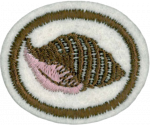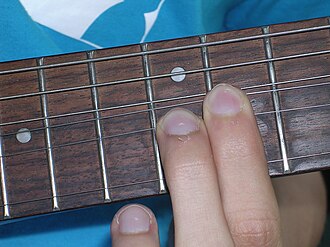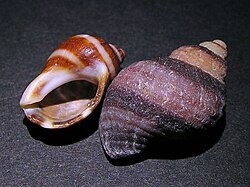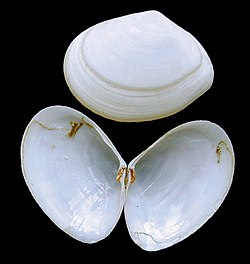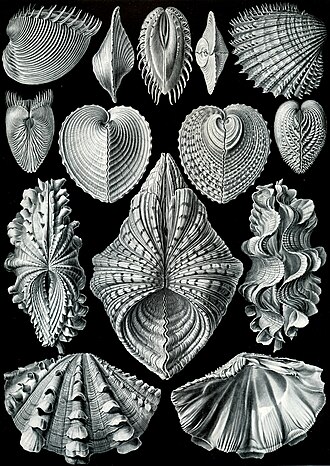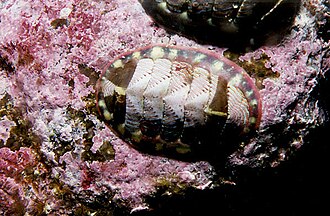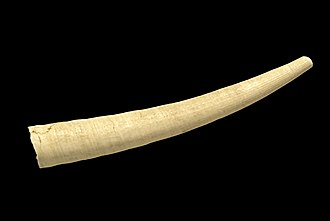Difference between revisions of "AY Honors/Shells/Answer Key/es"
(Created page with "{{clear}}") |
(Created page with "{{clear}}") |
||
| Line 119: | Line 119: | ||
Bivalves typically have two-part shells, with both valves being symmetrical along the hinge line. The class has 30,000 species, including scallops, clams, oysters and mussels. | Bivalves typically have two-part shells, with both valves being symmetrical along the hinge line. The class has 30,000 species, including scallops, clams, oysters and mussels. | ||
| − | + | {{clear}} | |
Bivalves are unique among the molluscs for lacking a radula; they feed by siphoning and filtering large particles from water. Some bivalves are epifaunal: that is, they attach themselves to surfaces in the water, by means of a byssus or organic cementation. Others are infaunal: they bury themselves in sand or other sediments. These forms typically have a strong digging foot. Some bivalves, such as scallops, can swim. | Bivalves are unique among the molluscs for lacking a radula; they feed by siphoning and filtering large particles from water. Some bivalves are epifaunal: that is, they attach themselves to surfaces in the water, by means of a byssus or organic cementation. Others are infaunal: they bury themselves in sand or other sediments. These forms typically have a strong digging foot. Some bivalves, such as scallops, can swim. | ||
Revision as of 13:15, 28 February 2021
| Moluscos | ||
|---|---|---|
| Asociación General
|
Destreza: 2 Año de introducción: 1938 |
|
Requisitos
1
2
2a
2b
2c
2d
2e
2f
2g
2h
2i
3
4
Mollusks have several methods of getting around, depending on the species. Some have tiny hair-like structures on the foot called cilia which they use to propel themselves through a slimy substance they secrete. Others generate waves of motion along the length of the foot. Still others pump water through their shells and let the resulting jet push them forward.
5
Mollusks pull the soft portion of their bodies into their shells and seal the entry with their operculum. They can also burrow below the surface of the seafloor, river banks, river bottoms, or lake banks and lake bottoms.
6
Shells are formed when the animal secretes calcium carbonate from the mantel. The calcium carbonate hardens into a shell. The apex of the shell is formed first, and as the animal grows, more is added to the shell at the opening.
7
Shells have been used by man in the following ways:
- Money
- Shells have been used in many cultures as a form of money.
- Buttons
- Buttons were originally cut from shells. Plastic buttons we use today still resembled the pearly surface of the inside of a seashell.
- Adornment
- Many cultures made (and make) jewelry from shells. Holes can be drilled into shells to make beads. Shells are also inlaid into wood in an artform called intarsia (also in marquetry and parquetry).
- Hair combs
- Shells have been cut to shape and used to comb hair.
- Fret board markers
- The markers (often round dots) between the frets on the fingerboard of a guitar (or other stringed instrument) are made of shell.
- Utensils
- Shells were used to make spoons, knives, cups, and dishes by primitive cultures.
- Chemistry
- Shells are made from calcium carbonate, a chemical useful in the laboratory. Calcium carbonate is widely used medicinally as an inexpensive dietary calcium supplement or antacid. It is also used in the pharmaceutical industry as a base material for tablets of other pharmaceuticals.
- Lime
- Seashells can be crushed to make lime which is used to raise the pH level in soil.
8
A bivalve is a mollusk with a two-part shell, such as an oyster, clam, scallop, or mussel. A univalve is a mollusk with a one-part shell, such as a snail, conch, or whelk.
9
Bivalves
Bivalves typically have two-part shells, with both valves being symmetrical along the hinge line. The class has 30,000 species, including scallops, clams, oysters and mussels.
Bivalves are unique among the molluscs for lacking a radula; they feed by siphoning and filtering large particles from water. Some bivalves are epifaunal: that is, they attach themselves to surfaces in the water, by means of a byssus or organic cementation. Others are infaunal: they bury themselves in sand or other sediments. These forms typically have a strong digging foot. Some bivalves, such as scallops, can swim.
The radical structure of the bivalves affects their behavior in several ways. the most significant is the use of the closely-fitting valves as a defense against predation and, in intertidal species such as mussels, drying out. The entire animal can be contained within the shell, which is held shut by the powerful adductor muscles. This defense is difficult to overcome except by specialist predators such as the Starfish and Oyster Catcher.
Gastropods
The gastropods, also previously known as gasteropods, or univalves, and more commonly known as snails and slugs, are the largest and most successful class of mollusks, with 60,000-75,000 known living species. This class of animals is second only to insects in its size and diversity.
The class Gastropoda includes very large numbers of marine snails and sea slugs, as well as the freshwater snails, and the terrestrial (land) snails and slugs.
Although the word snail can be, and often is, applied to all the members of this class, very commonly the word "snail" is restricted only to those species which have an external shell. Those without a shell, or with only a very reduced or internal shell, are often known as slugs.
The marine shelled species of gastropod include abalone, cowries, conches, periwinkles, whelks, so the word snail can be used to apply to them and the majority of other sea snails which have coiled seashells. There are also a number of families of species where the shell is coiled only in the larval stage, such as all the various limpets.
Cephalopods
The class Cephalopod contains two subclasses. In the Coleoidea, the mollusk shell has been internalized or is absent; this subclass includes the octopuses, squid, and cuttlefish. In the Nautiloidea the shell remains; this subclass includes the nautilus. There are around 786 distinct living species of Cephalopods.
Chitons
Chitons or coat of mail shells are small to large, primitive marine mollusks in the class Polyplacophora. There are 900 to 1,000 extant species of chitons in the class Polyplacophora.
Chitons are also sometimes commonly called sea cradles and they may also be referred to as loricates, polyplacophorans, and rarely polyplacophores.
Chitons have a shell composed of eight separate but shelly plates, which are held together with a structure known as a girdle.
Chitons live on hard surfaces such as on or under rocks, or in rock crevices. Some species live quite high in the intertidal zone and are exposed to the air and light for long periods. Others live subtidally. A few species live in deep water, as deep as 6,000 m ![]() .
.
Chitons have shells made up of eight overlapping calcareous valves held together and surrounded by a girdle. In many species the surface of the girdle is covered in, or decorated with, scales, hair-like protrusions, or glassy bristles.
After a chiton dies, the individual valves which make up the 8-part shell come apart, and may sometimes wash up in beach drift. The individual shelly plates from a chiton are sometimes called "butterfly shells" because of their shape.
Tusk Shells
The tusk shells vary in size from very small to medium sized. The official name of this class is Scaphopoda, meaning "shovel-footed".
These mollusks live on soft substrates offshore (usually not intertidally). Because of this subtidal habitat and their small size, many beachcombers are unfamiliar with them; their shells are usually not nearly as common or as easily visible in the beach drift as the shells of sea snails and clams.
10
You can collect shells on beaches or buy them at craft stores. If buying them, it is cheaper to buy a variety pack rather than getting them individually. Once you have 20 different types of shells, you can begin the process of identifying them. For this you will need a field guide such as one of these:
- National Audubon Society Field Guide to North American Seashells
- Seashells of North America: A Guide to Field Identification
You may be able to find a field guide at your local library too.
11
Source of Pearls
A pearl is a hard, rounded object produced within the soft tissue (specifically the mantle) of a living shelled mollusk. The finest quality pearls have been highly valued as gemstones and objects of beauty for many centuries, and the word pearl has become a metaphor for something rare, fine, and admirable.
Technically speaking, under the right set of circumstances almost any shelled mollusk can produce some kind of "pearl". However, most molluscan "pearls" have no luster or iridescence. In fact, the great majority of mollusk species produce pearls which are not attractive to look at, and not durable, such that they usually have no value at all, except perhaps to a scientist, or as a curiosity.
Desirable pearls are produced by two very different groups of molluscan bivalves or clams: marine pearl oysters from the family Pteriidae and freshwater pearl mussels from the order Unionida, families Unionidae and Margaritiferidae. These two families of bivalves have shell linings that are composed of nacre, or "mother of pearl" as it is more commonly known. A valuable natural pearl is entirely made from layers of nacre, using the same spontaneous process as is used in the creation of the nacre lining the shell.
Pearls are formed inside the shell of certain bivalve mollusks. As a response to an irritant inside its shell, the mollusk creates a pearl to seal off the irritation.
The mantle of the mollusk deposits layers of calcium carbonate (CaCO3) in the form of the minerals aragonite or calcite (both crystalline forms of calcium carbonate) held together by an organic horn-like compound called conchiolin. This combination of calcium carbonate and conchiolin is called nacre, or as most know it, mother-of-pearl. The commonly held belief that a grain of sand acts as the irritant is in fact rarely the case. Typical stimuli include organic material, parasites, or even damage that displaces mantle tissue to another part of the animal's body. These small particles or organisms enter the animal when the shell valves are open for feeding or respiration.
Spiritual Lessons
There are many spiritual lessons that can be drawn from a pearl. First is that pearls are fairly rare, and highly valuable. When Jesus told his parable of the pearl, everyone in his audience understood that if a person were to find a pearl in nature, it would be his free for the taking, and it would make him rich. Jesus was offering them eternal life - also free for the taking, and highly valuable.
A second lesson can be drawn from the way a pearl is made. It starts out as an irritant which the mollusk covers and turns into an item of beauty. In the same way, Christ covers our irritants with his robe of righteousness, converting us from miserable, doomed sinners into heirs of the eternal kingdom.
Ellen. G. White Comments
Ellen White's book Christ's Object Lessons can be read online. The pages called out here can be found here.
12
| Levítico 11:9 y 10 | a. ¿En qué día fueron creadas las criaturas acuáticas? |
| Hechos 16:14 | b. El número de criaturas acuáticas es innumerable. |
| Isaías 50:2 | c. Criaturas acuáticas perecen fuera del agua. |
| Apocalipsis 21:21 | d. Job consideró el coral de gran valor. |
| 1 Timoteo 2:9 | e. Salomón estaba familiarizado con la vida marina. |
| Génesis 1:20 y 21 | f. Jesús utiliza 2 veces una concha para enseñar una lección espiritual. |
| 1 Reyes 4:33 | g. Una empresaria se dedicaba a la venta de los famosos tintes de púrpura garantizados, tomado de los mariscos del Mediterráneo llamado Murex. |
| Salmo 104:25 | h. Pablo no apoya el uso de perlas. |
| Mateo 7:6; 13:45 y 46 | i. Los moluscos son impropios para la alimentación. |
| Job 28:18 | j. Las 12 puertas de la Santa Ciudad son 12 perlas. |
All scripture passages below are from the New International Version.
- a. Water creatures were created on what day?
- And God said, "Let the water teem with living creatures, and let birds fly above the earth across the expanse of the sky." So God created the great creatures of the sea and every living and moving thing with which the water teems, according to their kinds, and every winged bird according to its kind. And God saw that it was good. Genesis 1:20, 21 NIV
- b. The number of water creatures is innumerable.
- There is the sea, vast and spacious,
- teeming with creatures beyond number—
- living things both large and small. Psalms 104:25
- c. Water creatures perish out of water.
- When I came, why was there no one?
- When I called, why was there no one to answer?
- Was my arm too short to ransom you?
- Do I lack the strength to rescue you?
- By a mere rebuke I dry up the sea,
- I turn rivers into a desert;
- their fish rot for lack of water
- and die of thirst. Isaiah 50:2
- d. Job considered coral of great value.
- Coral and jasper are not worthy of mention; the price of wisdom is beyond rubies. Job 28:18
- e. Solomon was acquainted with marine life.
- He described plant life, from the cedar of Lebanon to the hyssop that grows out of walls. He also taught about animals and birds, reptiles and fish. 1 Kings 4:33
- f. Jesus twice used a shell product to teach a spiritual lesson.
- "Do not give dogs what is sacred; do not throw your pearls to pigs. If you do, they may trample them under their feet, and then turn and tear you to pieces. Matthew 7:6
- "Again, the kingdom of heaven is like a merchant looking for fine pearls. When he found one of great value, he went away and sold everything he had and bought it. Matthew 13:45,46
- g. A businesswoman was engaged in selling the famous purple dyes secured from the shellfish Mediterranean Murex.
- One of those listening was a woman named Lydia, a dealer in purple cloth from the city of Thyatira, who was a worshiper of God. The Lord opened her heart to respond to Paul's message. Acts 16:14
- h. Paul does not support the wearing of pearl
- I also want women to dress modestly, with decency and propriety, not with braided hair or gold or pearls or expensive clothes. 1 Timothy 2:9
- i. Shell creatures are unfit for food.
- " 'Of all the creatures living in the water of the seas and the streams, you may eat any that have fins and scales. But all creatures in the seas or streams that do not have fins and scales—whether among all the swarming things or among all the other living creatures in the water—you are to detest. Leviticus 11:9,10
- j. The twelve gates of Holy City are twelve pearls.
- The twelve gates were twelve pearls, each gate made of a single pearl. The great street of the city was of pure gold, like transparent glass. Revelation 21:21
Referencias
- Categoría: Tiene imagen de insignia
- Adventist Youth Honors Answer Book/Honors/es
- Adventist Youth Honors Answer Book/es
- Adventist Youth Honors Answer Book/Skill Level 2/es
- Categoría: Libro de respuestas de especialidades JA/Especialidades introducidas en 1938
- Adventist Youth Honors Answer Book/General Conference/es
- Adventist Youth Honors Answer Book/Nature/es
- Adventist Youth Honors Answer Book/Nature/Primary/es
- Adventist Youth Honors Answer Book/Stage 0/es
